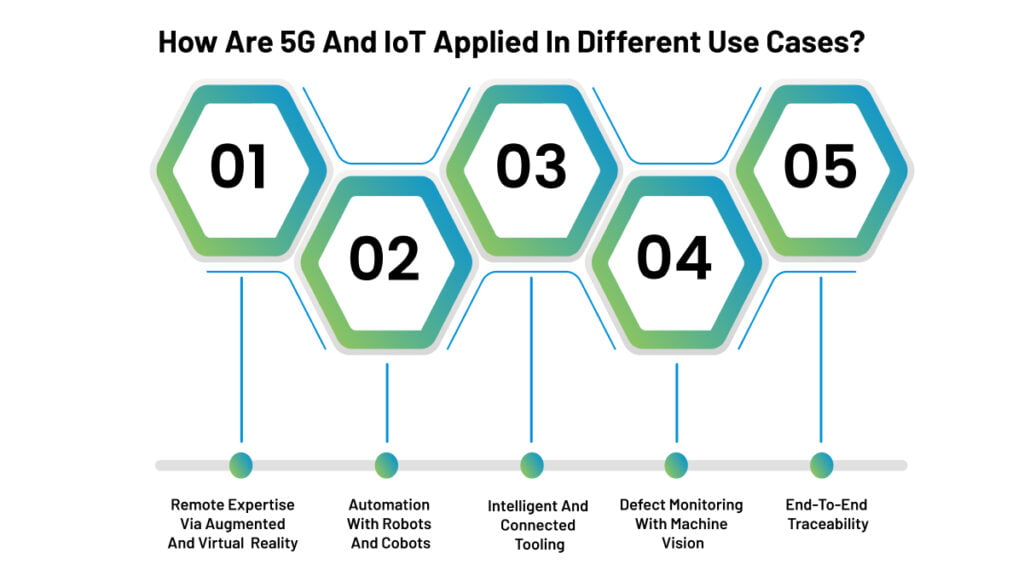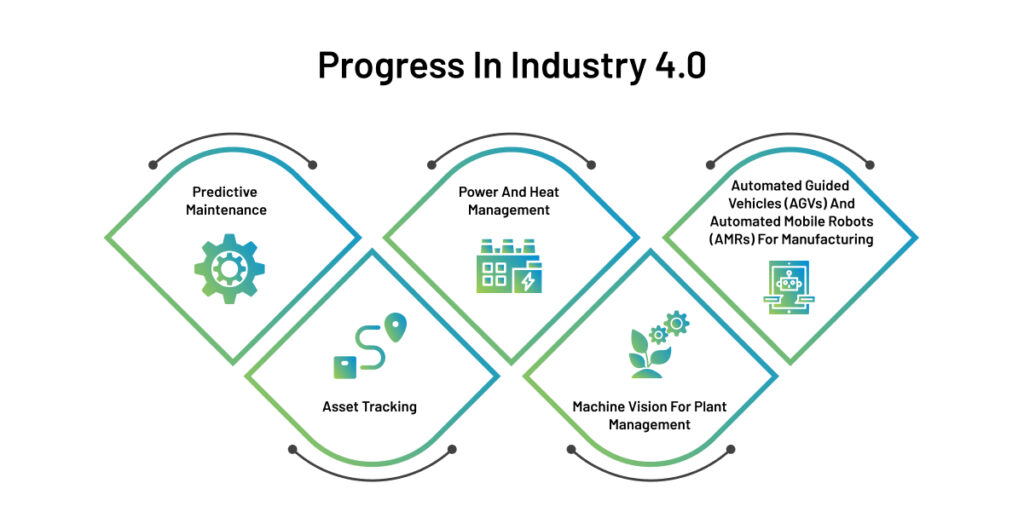The Internet of Things, or IoT, impacts every possible sector around us, especially manufacturing. The technology has the potential to transform traditionally linear systems into dynamic and interconnected ones, becoming the most significant driver of change in factories and other facilities of Industry 4.0 or smart factories. IoT depends on low-power and long-range connections, making it the “go-to” choice for manufacturing operations.
Along with IoT, nationwide 5G connectivity enhances operations’ overall speed, efficiency, and performance, unlocking new use cases for an IoT solutions company. A 2021 report from Bloor Research suggests that the future of 5G, edge computing, and IoT are critical enablers for industry 4.0. In addition, the market of IoT is forecasted to grow from $78.8 billion in 2021 to $98.2 billion by 2024, according to a forecast report from Markets and Markets.
The use of 5G and IoT combined enables closing of significant gaps in Industry 4.0, providing connectivity for billions of IoT devices and transferring and processing enormous volumes of data generated after that.
Overall, what you will take away from this blog is as follows:
- Revolutionizing Industry 4.0 with IoT and 5G
- Use Cases for 5G and IoT in Industry 4.0
- Enhancing Factories and industry 4.0
Revolutionizing Industry 4.0 with the use of IoT and 5G
The expansion of 5G and the adoption of IoT leads to a range of opportunities, including optimization of new projects, access to information for proper decision-making, and, thereby, enhancement of overall processes. Based on a study conducted by McKinsey and Company, 5G contributes to optimizing industrial operations, making daily management of assets and people more efficient.
5G and IoT applications in manufacturing account for more than 32 to 39 percent of the total IoT economic value. This implies around $0.5 trillion to $1.3 trillion by 2030. A report map to prosperity published a few years back in 2019 and organized by the Center of Rural Affairs in the United States suggests that the number of broadband connections is directly related to the number of job opportunities. These are so impactful that 5G could represent a massive platform for digital transformation around.
Moreover, another study suggests that about 35% of US manufacturers use data from smart sensors. In manufacturing, multiple data-intensive machines are often used in proximity. This is why 5G connectivity is the key to success.
Also, Read – Top 7 IoT Trends Driving Innovation Across Businesses In 2023
How are 5G and IoT Applied in Different Use Cases?
To think of the application of 5G and IoT, all you need to understand is that it delivers data from devices to the central cloud and then to different models to redefine them completely. For instance, data from road conditions collected through other vehicles can help create a cloud-based mapping service for a city- a service that we use daily.
Highly digitalized and connected devices like robots, cobots, and other devices help to automate your business operations and make them fully autonomous. Other than these benefits, there are different use cases that an IoT solutions company can use to make the most of the opportunity at hand. For example, here are some use cases that business owners can think of while adopting 5G and IoT!

- Remote Expertise via Augmented and Virtual Reality: 5G enables higher bandwidth density for improved video resolution, reduces visual lag, and supports more users in any area. Also, it helps with seamless mobility throughout and beyond the manufacturing site.
- Automation with Robots and Cobots: 5G extends capabilities into real-time or near real-time control to improve throughput, quality, and safety. IoT and 5G in a specific area also enable a higher density of robotic and cobot equipment supportable. Additionally, an IoT app development company may provide benefits like higher-resolution video, additional camera angles, and factory and plant-wide mobility for moving robots and cobots.
- Intelligent and Connected Tooling: Low latency and high reliability enable settings to be updated in a real-time. Data recording and tool control in real-time is another benefit that comes along with it. Moreover, 5G enables seamless mobility, factory-wide and floor-wide manufacturing.
- Defect Monitoring with Machine Vision: Video transmission latency tends to be reduced with additional bandwidth and higher definition imaging supported to improve sensitivity and rejection of defects.
- End-to-end traceability: 5G enables higher scalability of traceability solutions. It also supports higher device densities, more and higher resolutions of CCTV cameras used for tracing, and guarantees over communications when using ultra-reliable, low latency communications.
Progress in Industry 4.0
As the fourth Industrial Revolution continues transforming the manufacturing industry, different businesses seek more innovative solutions to enhance their operations. As we have already established, using 5G combined with a state-of-the-art dedicated IoT connection can emerge as a game changer. With cloud revolutions, businesses could take massive steps toward optimizing their processes. And as Industry 4.0 accelerates, an IoT solutions company may expect to see more businesses investing in private 5G networks to enhance operations, reduce costs and stay ahead of the game. Here are some ways business owners can progress in Industry 4.0 with the two disrupting technologies.

- Predictive Maintenance: Larger numbers of simple and complex sensors can be supported on 5G networks, and with higher data rates available, there is support for more excellent frequency sampling and higher precision sampling for critical data such as low and high-volume voltage, current, temperature, and noise sampling. When using lower data rate sensors, 5G networks support the massive deployment of such sensors allowing more points to be monitored throughout the production line, factory facility (energy, water, and HVAC), warehouse, and transportation functions.
- Asset Tracking: Tracking is extended beyond the factory floor or production plant to a national/international footprint via public mobile networks. 5G optimizations enable efficient massive-scale deployment of tracking solutions, support for multiyear battery life, and application control over the duty cycle. Additional data can readily be sent, including environmental data. Devices can also be ‘woken’ from the network for active tracking. CCTV cameras for asset monitoring can also be deployed at a large scale and support high-resolution imaging.
- Power and Heat Management: In a high sensor/controller density environment, 5G efficiently enables a much larger number of devices to be supported. Ultra-reliable low latency communications are a crucial advantage of 5G – ensuring control actions are performed in real-time or near real-time and with total confidence. High-quality coverage can also be delivered reliably, indoors and outdoors, seamlessly using the three complementary spectrum regions.
- Machine Vision for Plant Management: 5G enables an increased density of higher resolution CCTV to be deployed, improving the range and accuracy of machine vision applications. When machine vision identifies a situation that requires action, the ultrareliable low latency communications support within 5G ensures immediate and guaranteed response, such as shutting down equipment that might risk an employee’s safety. The soft, medium, and high-frequency band support within 5G and multiple antennae (MIMO) / beamforming support help ensure complete indoor, outdoor, and building fabric site coverage for these applications
- Automated Guided Vehicles (AGVs) and Automated Mobile Robots (AMRs) for Manufacturing: The increased bandwidth available on 5G also enables additional camera perspectives to be relayed with lower latency and higher resolution permitting better decision-making for traffic coordination and safety. This is also very important for LIDAR data transmission. Control actions have rapid and guaranteed delivery with ultra-reliable, low-latency communications to achieve maximum efficiency and operation safety.
Also, Read – Challenges Industries Face In IoT Implementation
In the End!
In conclusion, the combination of 5G and IoT is a game changer for Industry 4.0. The widespread adoption of IoT in manufacturing has revolutionized traditional linear systems, and with the nationwide rollout of 5G, we can unlock new use cases that were previously impossible. This powerful duo enables factories and facilities to become more dynamic and interconnected, significantly improving efficiency, performance, and speed.
As the market for IoT solutions continues to grow, companies must stay ahead by investing in the latest technologies. With a projected market growth from $78.8 billion in 2021 to $98.2 billion by 2024, according to a forecast report from Markets and Markets, there is no doubt that IoT will play an increasingly critical role in the manufacturing industry. And with the added benefits of 5G connectivity, the possibilities for innovative solutions are endless.
Moreover, as more businesses seek to optimize their processes and reduce costs, they will turn to IoT app development companies and IoT solutions companies to provide private 5G networks that enhance their operations. The potential use cases for 5G and IoT include remote expertise via augmented and virtual reality, automation with robots and cobots, intelligent and connected tooling, defect monitoring with machine vision, and end-to-end traceability.
Overall, the combination of 5G and IoT is a crucial enabler for Industry 4.0, providing connectivity for billions of IoT devices and processing enormous volumes of data generated by them. As the fourth industrial revolution continues to transform the manufacturing industry, it’s clear that the integration of 5G and IoT is essential for businesses seeking to progress and stay competitive.




